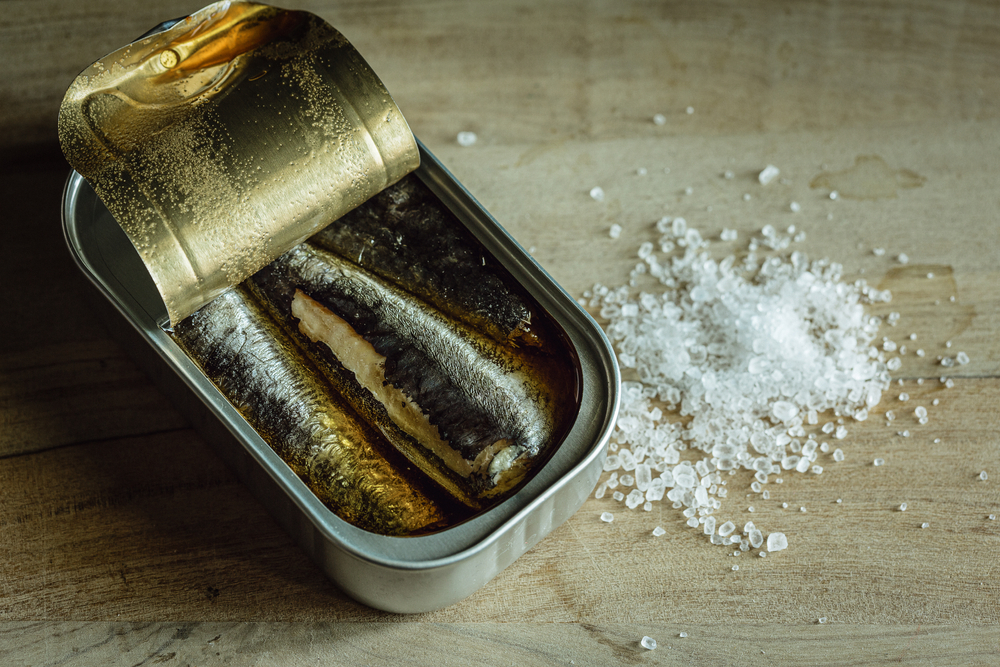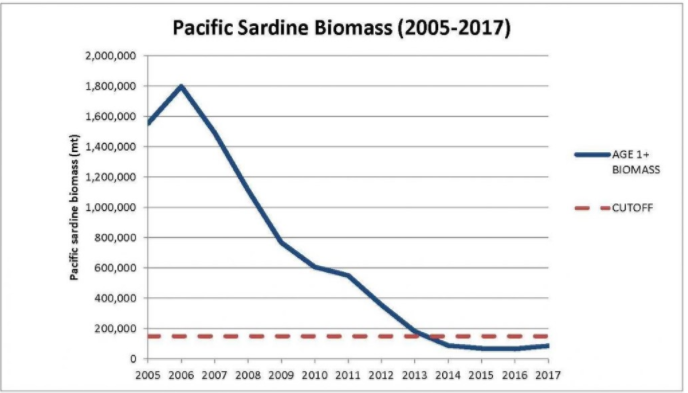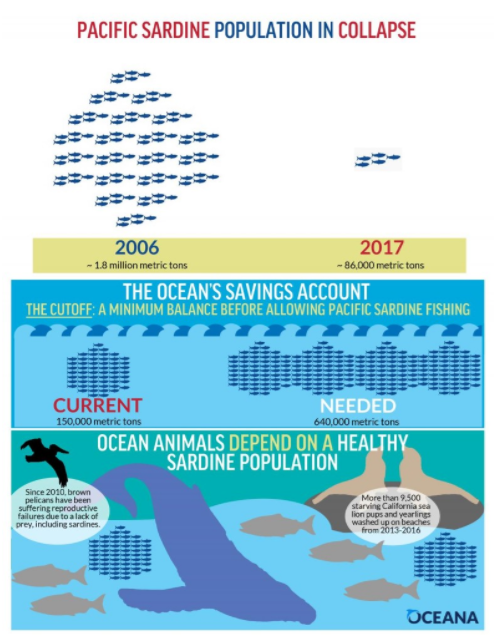Fresh Sardines or Canned Sardines: No Longer an Option for Americans

Introduction
From 2006 to 2017 a dramatic collapse occurred in the Northern Pacific Sardine population (extending from Baja California to British Columbia, Canada), amounting to a 95 % decline in the entire sardine population (Figure 1, Info graphic 1) (1-3).

Figure 1.The Pacific sardine population (biomass in millions of tons) has declined 95 percent since 2006 and it is now below the minimum level required to support a commercial fishery (called the “cutoff”) (1, 3).
This fishery collapse caused biologists at the West Coast Region of the National Oceanic and Atmospheric Administration (NOAA) Fisheries to impose a moratorium on all commercial sardine fishing in the Northern Pacific Sardine population (including California, Oregon and Washington) for 2015, 2016, 2017 and then on through to June 30, 2018 (1-3) – a 4-year moratorium, which will likely be extended (2).
Accordingly, fresh Pacific sardines have disappeared entirely from U.S. supermarkets and fish dealers and elsewhere worldwide. For any U.S. consumer wanting to purchase fresh sardines, you are now limited to a single high volume fish vendor in New York City (The Lobster Place: https://lobsterplace.com/) which imports “fresh” sardines seasonally from Spain.
Only a single on-line U.S. merchant (https://wholey.com/sardines/) sells frozen sardines – also caught in Spanish waters. These flash frozen fish retail at $64 for an 8-pound bag of sardines. This cost is difficult to justify for frozen sardines when fresh salmon, mackerel or herring with comparable or superior omega 3 fatty acid concentrations are regularly available throughout the U.S.
Infographic 1.

The current cost to import either “fresh” or flash frozen sardines from Spain or other Mediterranean countries to a select few U.S. markets represents an exorbitant expense when compared to other U.S. fresh, fatty fish such as salmon, mackerel and herring. Hence, U.S. consumers now infrequently or never can purchase fresh or even flash frozen sardines at a reasonable cost. The net result is that almost all U.S. consumers of sardines now have no choice but to eat canned sardines.
Canned Sardines
As The New York Times reported, the last sardine cannery in the U.S. closed its doors on April 18, 2010 in Prospect Harbor, Maine (4). This action brought a final closure to our once thriving national, sardine packing industry which peaked during WWII and served as the backdrop of John Steinbeck’s gritty novel, “Cannery Row”.
U.S. sardine canneries have been declining for 60 years and have now completely fallen victim to foreign competition because of: (1) less restrictive foreign fishing policies, (2) foreign disregard for U.S. consumer health and safety regulations, (3) foreign obliviousness to global environmental laws, and (4) low-cost foreign labor to process and can sardines. The net result of these actions has been to produce an un-sustainable global sardine industry of unrestrained catches along with no international health or safety regulations for canned sardines and human health.
Excessive sardine catches during the same period in which natural environmental factors wax and wane to normally reduce sardine populations, creates an unsustainable situation which can eventually deplete or eliminate sardine populations (1-3). Most marine biologists studying Pacific sardine populations understand the multitude of factors which operate synergistically to deplete sardine populations. Unfortunately, my blog may be the first that you (most sardine consumers) have heard of this dismal situation for Pacific sardines.
Marine biologists studying the collapse of Pacific sardine populations are well aware of this ecologic disaster, but unfortunately are generally unaware of the nutritional and health consequences of our reliance upon canned sardines in lieu of fresh sardines.
The Nutritional and Health Consequences of Eating Canned Sardines
Although the nutritional and health consequences of eating canned sardines versus eating fresh sardines may initially seem inconsequential, this viewpoint is flawed. For U.S. consumers who can’t purchase fresh sardines, this is a moot point. Let’s examine the data.
Canned vs. Fresh Sardines
The canned sardines we consume in the U.S. actually are not a single fish species, but may represent one of 21 small marine fish species within the family (Clupeidae), that fall into the following four genera’s: Sardina, Sardinops, Sardinella, Dussumieria (5). Frequently, lack of quality control in the global sardine canning industry results in numerous small fish being packed and labeled as “sardines” when in fact they are not sardines, but other species (5).
In order to understand why canned sardines may represent a nutritional and health risk for human consumption, it is necessary to follow the steps involved in catching wild sardines as they are processed and packed into the tinned cans we purchase at the supermarket.
After sardines are caught at sea, usually via encircling nets called purse seines, a number of processing steps may occur when the fish are intended for human consumption via canning. Depending upon boat size, time at sea and distance to the cannery the sardines are put into brine tanks, which are either cooled or uncooled, or placed on ice. If there is a local market for these seined fish, they can be sold as “fresh” sardines, as long as refrigerated conditions are maintained for a few days to a week. Sometimes, sardines are flash frozen at sea and can then be marketed worldwide as “frozen”.
At the cannery, the sardines are normally washed, eviscerated and their heads removed. The fish then are cooked, typically by deep-frying in soybean or olive oil or by steam-cooking, after which they are dried. The sardines are then packed by hand into cans containing salt (brine), or (olive, sunflower or soybean oil with salt), or salt containing tomato, chili or mustard sauces. The cans are sealed and then heated above the boiling point via pressure cooking (called retort cooking) for 2 to 4 hours. This process is employed to kill all bacteria including those that cause botulism.
Deleterious Nutritional and Health Effects from Consuming Canned Sardines
High Salt and Low Potassium Content in Canned Sardines
Table 1 below demonstrate how salt is nearly universally added to commercially canned sardines. Fresh sardines like virtually all other unadulterated marine and fresh water fish contain more potassium than sodium (8). Notice that fresh sardines contain 4.04 times more potassium than sodium on a milligram by milligram basis compared to average processed sardines. Conversely, canned sardines contain exceptionally higher sodium concentrations and lower potassium concentrations than fresh sardines.
Table 1. Comparison of the sodium (Na+) and potassium (K+) concentrations between fresh and canned sardines (from citation 7) .


The Formation of Oxidized Cholesterol by Products in Canned Sardines
Perhaps the least appreciated, but most important change in the nutritional quality of canned sardines (or any canned fish product) compared to their fresh counterpart is the formation of oxidized cholesterol by-products (40, 41). Oxidized cholesterol by products are known to scientists as “oxysterols” and maintain multiple deleterious effects upon human health (42-46). Oxysterols occur universally with the canning and processing of fish and seafood (40) and are associated with a multiplicity of chronic diseases including atherosclerosis (coronary heart disease), neurodegenerative diseases, inflammatory bowel diseases, and age related macular degeneration (40-46).
Canned fish and seafood products such as sardines (canned tuna, salmon, herring, shrimp, oysters etc.) are particularly susceptible to the formation of cholesterol oxides (oxysterols). These fish and seafood products also contain high concentrations of long chain omega 3 fatty acids (docosahexaenoic acid [DHA], eicosapentaenoic acid [EPA] which have multiple beneficial health effects when they are consumed fresh. Nevertheless, the long chain omega 3 fatty acids (DHA and EPA) found in canned fish and seafood are highly susceptible to thermal (heat) processing, and together with their endogenous cholesterol, yield highly toxic cholesterol oxide products (oxysterols) (40-46) that directly result from the retort cooking necessary to eliminate bacteria and botulism. The very same process (retort cooking) which frees humanity from developing fatal botulism in canned foods, directly promotes chronic systemic inflammation via the synthesis of oxysterols that underlie heart disease, cancer, neurodegenerative diseases and inflammatory bowel diseases (40-46).
Something as simple as eating canned sardines or canned tuna had never been considered to be a health risk, but the current evidence is undeniable, irrefutable and damning (40-46) particularly when canned sardines, fish and seafood are consumed on a regular basis. Do yourself a favor, eat fresh fish, the way nature has always intended, and avoid the salt and cholesterol oxides found in the tainted products we call canned fish.
References
1.//usa.oceana.org/responsible-fishing/modern-day-pacific-sardine-collapse-how-prevent-future-crisis
2.Hill, K.T., P.R. Crone, J.P. Zwolinski. 2017. Assessment of the Pacific sardine resource in 2017 for U.S. management in 2017-18. Pacific Fishery Management Council, April 2017 Briefing Book, Agenda Item G.5.a, Portland, Oregon. 146 p.
3.//www.westcoast.fisheries.noaa.gov/fisheries/pelagic/pacific_sardine_landings.html
4.//www.nytimes.com/2010/04/04/us/04cannery.html
5.https://en.wikipedia.org/wiki/Sardine#Genera
6.FC Lago, B Herrero, JM Vieites, M Espiñeira. FINS methodology to identification of sardines and related species in canned products and detection of mixture by means of SNP analysis systems. Eur Food Res Technol, 232 (6), 2011: 1077-1086.
7.Nutritionist Pro, nutritional software. //www.nutritionistpro.com/
8.https://docs.google.com/spreadsheets/d/18gh7VCq2PYlYodY3hCj1KJe3uc3c2rUgrLLEGLcBALw/edit#gid=0
9.Cordain L, Eaton SB, Sebastian A, Mann N, Lindeberg S, Watkins BA, O’Keefe JH, Brand-Miller J. Origins and evolution of the western diet: Health implications for the 21st century. Am J Clin Nutr 2005;81:341-54.
10.Carrera-Bastos P, Fontes Villalba M, O’Keefe JH, Lindeberg S, Cordain L. The western diet and lifestyle and diseases of civilization. Res Rep Clin Cardiol 2011; 2: 215-235.
11.Gotshall RW, Mickleborough TD, Cordain L. Dietary salt restriction alters pulmonary function in exercise-induced asthmatics. Medicine and Science in Sports and Exercise, 2000;32:1815-19.
12.Jantsch J, Schatz V, Friedrich D et al. Cutaneous Na+ storage strengthens the antimicrobial barrier function of the skin and boosts macrophage-driven host defense. Cell Metab. 2015 Mar 3;21(3):493-501.
13.Jantsch J, Schatz V, Friedrich D et al. Cutaneous Na+ storage strengthens the antimicrobial barrier function of the skin and boosts macrophage-driven host defense. Cell Metab. 2015 Mar 3;21(3):493-501.
14.Dmitrieva NI, Burg MB. Elevated sodium and dehydration stimulate inflammatory signaling in endothelial cells and promote atherosclerosis. PLoS One. 2015 Jun 4;10(6): e0128870. doi: 10.1371/journal.pone.0128870
15.Yi B, Titze J, et al. Effects of dietary salt levels on monocytic cells and immune responses in healthy human subjects: a longitudinal study. Transl Res. 2015 Jul;166(1):103-10.
16.Zhou X, et al. Variation in dietary salt intake induces coordinated dynamics of monocyte subsets and monocyte-platelet aggregates in humans: implications in end organ inflammation. PLoS One. 2013 Apr 4;8(4):e60332.
17.Ip WK, Medzhitov R. Macrophages monitor tissue osmolarity and induce inflammatory response through NLRP3 and NLRC4 inflammasome activation. Nat Commun. 2015 May 11;6:6931.
18.Foss JD, Kirabo A, Harrison DG. Do high-salt microenvironments drive hypertensive inflammation? Am J Physiol Regul Integr Comp Physiol. 2017 Jan 1;312(1):R1-R4
19.Min B, Fairchild RL. Over-salting ruins the balance of the immune menu. J Clin Invest. 2015 Nov 2;125(11):4002-4.
20.Amara S, Tiriveedhi V. Inflammatory role of high salt level in tumor microenvironment (Review). Int J Oncol. 2017 May;50(5):1477-1481
21.Kleinewietfeld M, et al. Sodium chloride drives autoimmune disease by the induction of pathogenic TH17 cells. Nature. 2013 Apr 25;496(7446):518-22
22.Schatz V, et al. Elementary immunology: Na+ as a regulator of immunity. Pediatr Nephrol. 2017 Feb;32(2):201-210.
23.Hernandez AL, et al. DA. Sodium chloride inhibits the suppressive function of FOXP3+ regulatory T cells. J Clin Invest. 2015 Nov 2;125(11):4212-22.
24.Wu C, et al. Induction of pathogenic TH17 cells by inducible salt-sensing kinase SGK1. Nature. 2013 Apr 25;496(7446):513-7.
25.Hucke S, et al.. Sodium chloride promotes pro-inflammatory macrophage polarization thereby aggravating CNS autoimmunity. J Autoimmun. 2016 Feb;67:90-101.
26.Zostawa J, et al. The influence of sodium on pathophysiology of multiple sclerosis. Neurol Sci. 2017 M
27.Khalili H et al. Identification and characterization of a novel association between dietary potassium and risk of crohn’s disease and ulcerative colitis. Front Immunol. 2016 Dec 7;7:554. doi: 10.3389/fimmu.2016.00554. eCollection 2016.
27.Sigaux J, et al. Salt, inflammatory joint disease, and autoimmunity. Joint Bone Spine. 2017 Jun 23. pii: S1297-319X(17)30129-X. doi: 10.1016/j.jbspin.2017.06.003.
28.Sundstrom B et al. Interaction between dietary sodium and smoking increases the risk for rheumatoid arthritis: results from a nested case-control study. Rheumatology 2015;54:487-493
29.Yang X et al. Exacerbation of lupus nephritis by high sodium chloride related to activation of SGK1 pathway. Int Immunopharm 2015;29:568-573.
30.Krementsov DN et al. Exacerbation of autoimmune neuroinflammation by dietary sodium is genetically controlled and sex specific. FASEB J 2017;29(8):3446-3457.
31.Jorg S et al. High salt drives Th17 responses in experimental autoimmune encephalomyelitis without impacting myeloid dendritic cells. Exp Neurol 2016;279:212-222
32.Schatz V, et al. Elementary immunology: Na+ as a regulator of immunity. Pediatr Nephrol. 2017 Feb;32(2):201-210.
33.Grivennikov SI, Wang K, Mucida D et al. Adenoma-linked barrier defects and microbial products drive IL-23/IL-17-mediated tumour growth. Nature. 2012 Nov 8;491(7423):254-8.
34.Safa K, et al. Salt accelerates allograft rejection through serum- and glucocorticoid-regulated kinase-1-dependent inhibition of regulatory t cells. J Am Soc Nephrol. 2015 Oct;26(10):2341-7
35.Hernandez AL, et al. Sodium chloride inhibits the suppressive function of FOXP3+ regulatory T cells. J Clin Invest. 2015 Nov 2;125(11):4212-22
36.Oberleithner H, et al. Plasma sodium stiffens vascular endothelium and reduces nitric oxide release. Proc Natl Acad Sci U S A. 2007 Oct 9;104(41):16281-16286.
37.Kusche-Vihrog K, Schmitz B, Brand E. Salt controls endothelial and vascular phenotype. Pflugers Arch. 2015 Mar;467(3):499-512
38.Ghimire K, et al. Nitric oxide: What’s new to NO? Am J Physiol Cell Physiol. 2016 Dec 14:ajpcell.00315.2016. doi: 10.1152/ajpcell.00315.2016. [Epub ahead of print]
39.Jeggle P, et al. Aldosterone synthase knockout mouse as a model for sodium-induced endothelial sodium channel up-regulation in vascular endothelium. FASEB J. 2016 Jan;30(1):45-53.
40.Dantas NM, Sampaio GR, Ferreira FS, Labre Tda S, Torres EA, Saldanha T. Cholesterol Oxidation in Fish and Fish Products. J Food Sci. 2015 Dec;80(12):R2627-39
41.Rodriguez-Estrada MT, Garcia-Llatas G, Lagarda MJ3 7-Ketocholesterol as marker of cholesterol oxidation in model and food systems: when and how. Biochem Biophys Res Commun. 2014 Apr 11;446(3):792-7.
42.Otaegui-Arrazola A, Menéndez-Carreño M, Ansorena D, Astiasarán I. Oxysterols: A world to explore. Food Chem Toxicol. 2010 Dec;48(12):3289-303
43.Zarrouk A, Vejux A, Mackrill J, O’Callaghan Y, Hammami M, O’Brien N, Lizard G. Involvement of oxysterols in age-related diseases and ageing processes. Ageing Res Rev. 2014 Nov;18:148-62
44.Kulig W, Cwiklik L, Jurkiewicz P, Rog T, Vattulainen I. Cholesterol oxidation products and their biological importance. Chem Phys Lipids. 2016 Sep;199:144-160
45.Vejux A, Lizard G. Cytotoxic effects of oxysterols associated with human diseases: Induction of cell death (apoptosis and/or oncosis), oxidative and inflammatory activities, and phospholipidosis. Mol Aspects Med. 2009 Jun;30(3):153-70
46.Poli G, Biasi F, Leonarduzzi G. Oxysterols in the pathogenesis of major chronic diseases. Redox Biol. 2013 Jan 31;1:125-30




